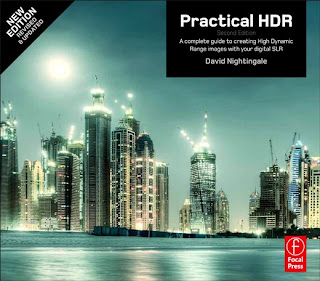
By David Nightingale
Focal Press (176 p) $24.95
ISBN-10: 024082122X
ISBN-13: 978-0240821221
The second edition of David Nightingale’s useful introductory volume provides an informative overview of the techniques and tools of High Dynamic Range (HDR) photography. HDR refers to pictures capturing a wider range of lights to darks than is typically possible with 8 bit camera-processed JPEGs. The book covers how a reader might 'tone map' raw files using post-processing techniques to achieve a look that often ranges from hyper-realistic (the human eye has a wider sensitivity to dynamic range than a digital sensor), to dreamlike. A wealth of software tools now exist to create these HDR images, and Nightengale devotes a good amount of ink to techniques using the most popular ones, including Photoshop CS5, Photomatix Pro, HDR Express, HDR Efex Pro, Olneo PhotoEngine. With post-processing know-how, Nightingale explains the range of effects possible within HDR, from extracting data from a single raw file in order to create a punchy and hyper-saturated graphic effect, to blending multiple pictures in order to achieve a more photo realistic result. While the use (and quite often over-use) of tone mapping has become an object of irritation in many photographic circles, Nightingale begins with the assumption that the reader is interested in the techniques and admires the look that it typically yields.
He includes many of his own accomplished landscapes, cityscapes, and urban studies to illustrate his text. The book also includes a few representative images from other prominent HDR proponents, such as Trey Radcliff. Many images are accompanied by EXIF data from the initial shots as well as information on the software used in post-production. While rife with practical information and best practices (i.e. taking five exposures at 1 EV intervals rather than three exposures at 2 EV increments) as well as tips to avoid banding, noise and other artifacts, the manual never gets overly technical or impenetrable.
A good deal of time is devoted to comparing techniques and results between competing software programs. This can be very helpful to those just starting to explore HDR and trying to decide which tools are best suited to their needs.
As is typical for books in the fast-moving tech industry, the second edition already has a few references that are out-of-date; allusions to Photoshop CS5 instead of the recently released CS6, for example. Nightingale takes pains to account for varying workflows and software; a bonus for those trying to decide which app to use. For those already committed to a particular piece of software and an established workflow, however, a lot of what is covered will hold little interest. But for readers interested in exploring the possibilities of HDR, especially newbies hoping to get their feet wet, Nightingale has provided a valuable resource.
Practical HDR, Second Edition is available on Amazon as a paperback and as a Kindle ebook.


















